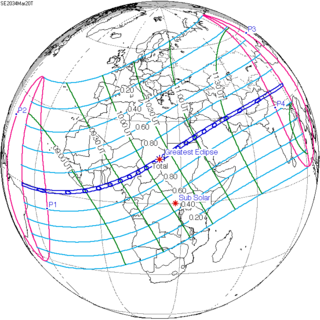
Back كسوف الشمس 20 مارس 2034 Arabic Sonnenfinsternis vom 20. März 2034 German خورشیدگرفتگی ۳۰ اسفند ۱۴۱۲ Persian Éclipse solaire du 20 mars 2034 French Eclissi solare del 20 marzo 2034 Italian 2034년 3월 20일 일식 Korean Zonsverduistering van 20 maart 2034 Dutch Eclipse solar de 20 de março de 2034 Portuguese Солнечное затмение 20 марта 2034 года Russian สุริยุปราคา 20 มีนาคม พ.ศ. 2577 Thai
| Solar eclipse of March 20, 2034 | |
|---|---|
| Type of eclipse | |
| Nature | Total |
| Gamma | 0.2894 |
| Magnitude | 1.0458 |
| Maximum eclipse | |
| Duration | 249 s (4 min 9 s) |
| Coordinates | 16°06′N 22°12′E / 16.1°N 22.2°E |
| Max. width of band | 159 km (99 mi) |
| Times (UTC) | |
| Greatest eclipse | 10:18:45 |
| References | |
| Saros | 130 (53 of 73) |
| Catalog # (SE5000) | 9583 |
A total solar eclipse will occur at the Moon's descending node of orbit on Monday, March 20, 2034,[1] with a magnitude of 1.0458. A solar eclipse occurs when the Moon passes between Earth and the Sun, thereby totally or partly obscuring the image of the Sun for a viewer on Earth. A total solar eclipse occurs when the Moon's apparent diameter is larger than the Sun's, blocking all direct sunlight, turning day into darkness. Totality occurs in a narrow path across Earth's surface, with the partial solar eclipse visible over a surrounding region thousands of kilometres wide. Occurring about 1.3 days before perigee (on March 21, 2034, at 18:15 UTC), the Moon's apparent diameter will be larger.[2]
Totality will be visible from Nigeria, northern Cameroon, Chad, Sudan, Egypt, Saudi Arabia, Kuwait, Iran, Afghanistan, Pakistan, northern India, and western China.[3] A partial eclipse will be visible for parts of eastern Brazil, Africa, Europe, the Middle East, Central Asia, and South Asia. Coincidentally, The eclipse passes through many Islamic countries around the date of Islamic New Year (estimated around March 20–21 according to local traditions, time zone and atmospheric conditions), and also passes through Iran only a few hours before the vernal equinox, marking the beginning of the Persian New Year. Since the Islamic lunar year is 11–12 days shorter than the solar year that the Iranian calendar observes, the Islamic New Year rotates through the seasons of the year, while the Persian one is on nearly fixed date on Gregorian calendar. It is an extremely rare case that the two new years meet.
- ^ "March 20, 2034 Total Solar Eclipse". timeanddate. Retrieved 14 August 2024.
- ^ "Moon Distances for London, United Kingdom, England". timeanddate. Retrieved 14 August 2024.
- ^ "Total Solar Eclipse on March 20, 2034: Path Map and Times". www.timeanddate.com. Retrieved 2024-04-19.
